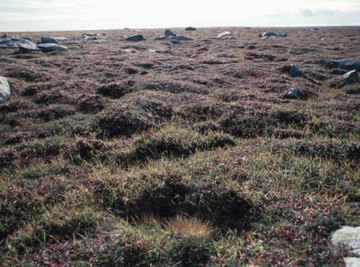
Shaped by wind, ice and snow, the tundra is a vast and seemingly barren region circumnavigating the northernmost edges of North America, Greenland and Eurasia. It is home to a variety of vegetation, including many species of shrub. Characterized by their low growth habit, the native shrubs of the Arctic thrive despite the extreme conditions under which they grow, providing a valuable food source for many native animal species.
Dwarf Birch
Dwarf birch (Betula nana) is found throughout the Arctic tundra region of North America, Greenland and northwestern Eurasia. It is a small deciduous shrub reaching a maximum height of four feet with a low, spreading growth habit. Striking in appearance, dwarf birch bears an abundance of small lobed leaves along its coppery-brown branches. The leaves turn crimson in autumn. Its range is restricted to the southernmost edge of the tundra near the taiga zone, an area of small, stunted trees.
Northern Labrador Tea
Among the most common and widespread shrubs in the tundra, northern Labrador tea (Rhododendron tomentosum) thrives in the peaty, acidic soil and bitter cold that is characteristic of the region. It is an extremely low-growing evergreen shrub seldom exceeding 1.5 feet in height, with a spreading habit. In midsummer, northern Labrador tea bears a profusion of brushy white flower clusters that are attractive to bees. The thick, tongue-shaped leaves are nearly black in appearance with a fine down of white hairs across the surface.
Arctic White Heather
Reaching three to 10 inches in height, Arctic white heather (Cassiope tetragona) is a dwarf flowering shrub common across the North American tundra. It also occurs in scattered thickets within the Scandinavian tundra of Lapland. Areas of slightly acidic, well-draining soil are particularly hospitable to Arctic white heather, and it frequently dominates rocky slopes near the southern edge of the tundra. It is unusual in appearance, bearing small, scalelike leaves along reddish-brown branches. During the summer months, it produces numerous white, bell-shaped flowers with a nodding posture.
Arctic Willow
Arctic willow (Salix arctica) occurs in tundra areas around the world, from North America to Eurasia. It is a diminutive species seldom exceeding six inches in height throughout most of its range. Not readily identifiable as a willow species, Arctic willow bears shiny green, rounded leaves covered in fine hairs. It blooms from late spring into summer, producing pink catkins on female plants and brown catkins on males.
White Dryad
One of the most unusual and striking shrubs of the tundra is white dryad (Dryas octopetala). Named for its flowers, white dryad bears a crop of proportionally large, poppy-like white flowers in late spring. It is a low-growing evergreen shrub with tough, woody stems and a spreading growth habit. Once established, it quickly colonizes large areas, choking out other vegetation. It reaches a mere three inches in height but can spread to cover an area larger than 10 square feet.
References
- "Plants of the Alpine Tundra"; Nic Marinos; 1991
- "Land Above the Trees: A Guide to American Alpine Tundra"; Ann Zwinger; 1989
- "Tundras: Vegetation, Wildlife and Climate Trends"; Beltran Gutierrez; 2009
About the Author
Samantha McMullen began writing professionally in 2001. Her nearly 20 years of experience in horticulture informs her work, which has appeared in publications such as Mother Earth News.
Photo Credits
Hemera Technologies/Photos.com/Getty Images
